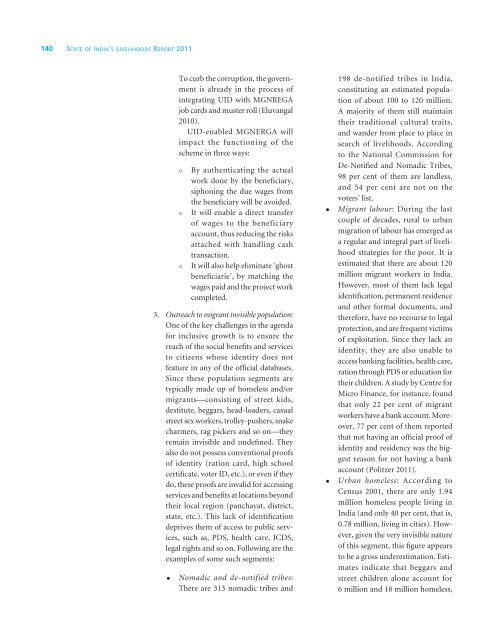SOIL Report 2011 - ACCESS Development Services
SOIL Report 2011 - ACCESS Development Services
SOIL Report 2011 - ACCESS Development Services
- No tags were found...
Create successful ePaper yourself
Turn your PDF publications into a flip-book with our unique Google optimized e-Paper software.
140 State of India’s Livelihoods <strong>Report</strong> <strong>2011</strong>To curb the corruption, the governmentis already in the process ofintegrating UID with MGNREGAjob cards and muster roll (Eluvangal2010).UID-enabled MGNERGA willimpact the functioning of thescheme in three ways:◦ By authenticating the actualwork done by the beneficiary,siphoning the due wages fromthe beneficiary will be avoided.◦ It will enable a direct transferof wages to the beneficiaryaccount, thus reducing the risksattached with handling cashtransaction.◦ It will also help eliminate ‘ghostbeneficiarie’, by matching thewages paid and the project workcompleted.3. Outreach to migrant invisible population:One of the key challenges in the agendafor inclusive growth is to ensure thereach of the social benefits and servicesto citizens whose identity does notfeature in any of the official databases.Since these population segments aretypically made up of homeless and/ormigrants—consisting of street kids,destitute, beggars, head-loaders, casualstreet sex workers, trolley-pushers, snakecharmers, rag pickers and so on—theyremain invisible and undefined. Theyalso do not possess conventional proofsof identity (ration card, high schoolcertificate, voter id, etc.), or even if theydo, these proofs are invalid for accessingservices and benefits at locations beyondtheir local region (panchayat, district,state, etc.). This lack of identificationdeprives them of access to public services,such as, PDS, health care, ICDS,legal rights and so on. Following are theexamples of some such segments:• Nomadic and de-notified tribes:There are 313 nomadic tribes and198 de-notified tribes in India,constituting an estimated populationof about 100 to 120 million.A majority of them still maintaintheir traditional cultural traits,and wander from place to place insearch of livelihoods. Accordingto the National Commission forDe-Notified and Nomadic Tribes,98 per cent of them are landless,and 54 per cent are not on thevoters’ list.• Migrant labour: During the lastcouple of decades, rural to urbanmigration of labour has emerged asa regular and integral part of livelihoodstrategies for the poor. It isestimated that there are about 120million migrant workers in India.However, most of them lack legalidentification, permanent residenceand other formal documents, andtherefore, have no recourse to legalprotection, and are frequent victimsof exploitation. Since they lack anidentity, they are also unable toaccess banking facilities, health care,ration through PDS or education fortheir children. A study by Centre forMicro Finance, for instance, foundthat only 22 per cent of migrantworkers have a bank account. Moreover,77 per cent of them reportedthat not having an official proof ofidentity and residency was the biggestreason for not having a bankaccount (Politzer <strong>2011</strong>).• Urban homeless: According toCensus 2001, there are only 1.94million homeless people living inIndia (and only 40 per cent, that is,0.78 million, living in cities). However,given the very invisible natureof this segment, this figure appearsto be a gross underestimation. Estimatesindicate that beggars andstreet children alone account for6 million and 18 million homeless,














